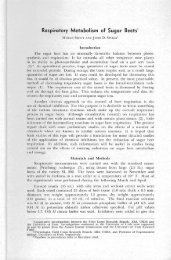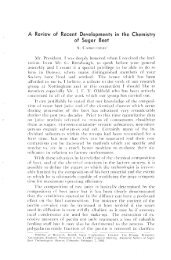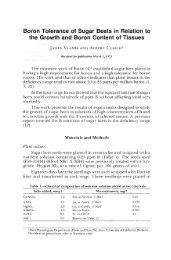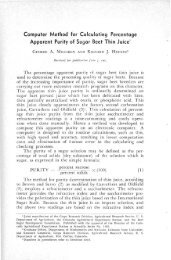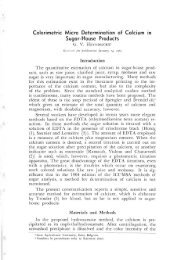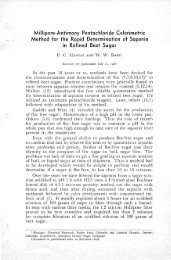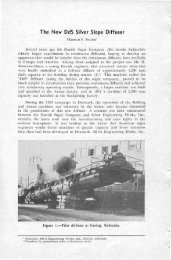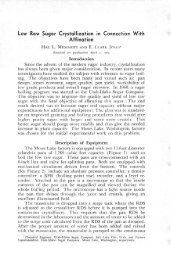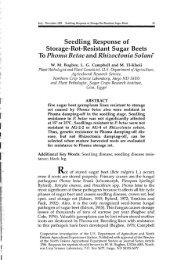Journal of Sugar Beet Research - Vol
Journal of Sugar Beet Research - Vol
Journal of Sugar Beet Research - Vol
Create successful ePaper yourself
Turn your PDF publications into a flip-book with our unique Google optimized e-Paper software.
2 <strong>Journal</strong> <strong>of</strong> <strong>Sugar</strong> <strong>Beet</strong> <strong>Research</strong> <strong>Vol</strong>. 45 Nos. 1 & 2<br />
improved control <strong>of</strong> Aphanomyces diseases <strong>of</strong> sugarbeet.<br />
Additional key words: Beta vulgaris, Aphanomyces cochlioides,<br />
biocontrol, Pseudomonas fluorescens, Burkholderia cepacia, harpin,<br />
induced systemic resistance.<br />
Seedling damping <strong>of</strong>f and chronic root rot <strong>of</strong> sugarbeet caused by<br />
Aphanomyces cochlioides Drecsh. (Dreschler, 1928) has caused<br />
historic and recent losses to producers in the Red River Valley <strong>of</strong><br />
Minnesota and North Dakota and other production regions <strong>of</strong> the United<br />
States. The pathogen is an oomycete, distantly related to Pythium<br />
and Phytophthora (Drechsler 1929, Dick, 1990). Zoospores are the<br />
infectious entity produced by the pathogen, whereas oospores are the<br />
stable resting stage <strong>of</strong> the organism, capable <strong>of</strong> surviving many years<br />
in the infested soil (Papavizas and Ayers, 1974; Park and Grau 1992).<br />
Seedling root rot disease is favored by warm, wet soils (Duffus and<br />
Ruppel, 1993); hence stand establishment is improved in soils known to<br />
contain the pathogen when seed is sown early in the spring when temperatures<br />
are cooler. Chronic root rot typically occurs in June and July<br />
in Minnesota and North Dakota following wet periods with seasonable<br />
temperatures. In 2000 alone, estimates <strong>of</strong> nearly 20% locally (Fargo,<br />
ND) and 4% total, <strong>of</strong> the sugarbeet hectares in the American Crystal<br />
<strong>Sugar</strong> Company’s factory districts were abandoned due to the chronic<br />
root rot caused by this pathogen (A. Cattanach, American Crystal <strong>Sugar</strong><br />
Company, pers. comm.).<br />
Although resistance active in young and mature beets has been<br />
characterized (Coe and Scheider, 1966), seedlings must be protected<br />
from A. cochlioides by seed treatment with the chemical hymexazol<br />
(TachigarenTM ; Windels, 1990; Payne and Williams, 1990). Since protection<br />
<strong>of</strong> the crop by this solitary compound is considered precarious,<br />
new measures for controlling black root and root rot disease continue to<br />
be investigated. Biocontrol using beneficial bacteria or fungi <strong>of</strong>fers one<br />
avenue for disease control that potentially would expedite product registration<br />
and provide season-long crop protection (Cook and Baker, 1983;<br />
Handelsman and Stabb, 1996). Biocontrol studies using bacterial species<br />
antagonistic to A. cochlioides have been described (Jacobsen et al.,<br />
2000; Williams and Asher, 1996; Kristek et al., 2006), but to date none<br />
are used in major sugarbeet producing regions. This is due in part to the<br />
lack <strong>of</strong> bacterial strains proven to provide protection under a wide range<br />
<strong>of</strong> environments, to the formulation <strong>of</strong> such organisms to meet industry<br />
and regulatory standards and practices, and to education regarding the<br />
most effective way to implement a biocontrol partner in an integrated



